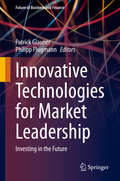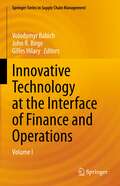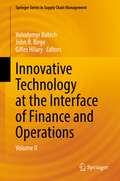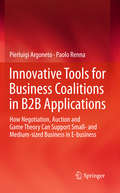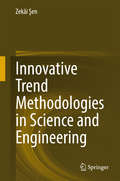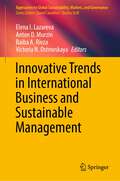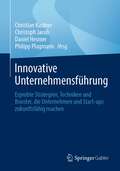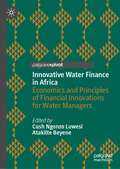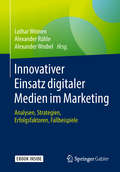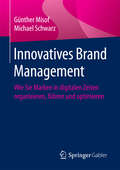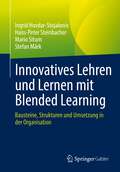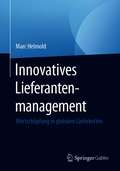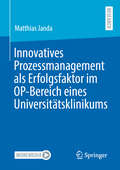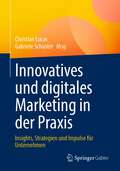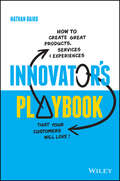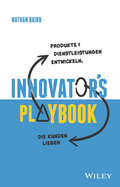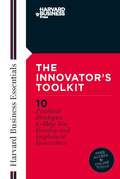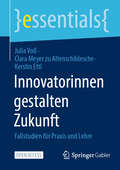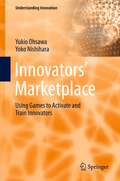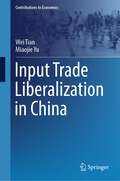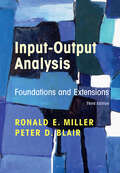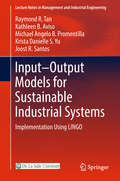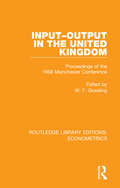- Table View
- List View
Innovative Technologies for Market Leadership: Investing in the Future (Future of Business and Finance)
by Philipp Plugmann Patrick GlaunerThis book introduces the reader to the latest innovations in fields such as artificial intelligence, systems biology or surgery, and gives advice on what new technologies to consider for becoming a market leader of tomorrow. Companies generally acquire information on these fields from various sources such as market reports, scientific literature or conference events, but find it difficult to distinguish between mere hype and truly valuable innovations. This book offers essential guidance in the form of structured and authoritative contributions by experts in innovative technologies spanning from biology and medicine to augmented reality and smart power grids. The authors identify high-potential fields and demonstrate the impact of their technologies to create economic value in real-world applications. They also offer business leaders advice on whether and how to implement these new technologies and innovations in their companies or businesses.
Innovative Technology at the Interface of Finance and Operations: Volume I
by John R. Birge Volodymyr Babich Gilles HilaryThis book examines the challenges and opportunities arising from an assortment of technologies as they relate to Operations Management and Finance. The book contains primers on operations, finance, and their interface. After that, each section contains chapters in the categories of theory, applications, case studies, and teaching resources. These technologies and business models include Big Data and Analytics, Artificial Intelligence, Machine Learning, Blockchain, IoT, 3D printing, sharing platforms, crowdfunding, and crowdsourcing.The balance between theory, applications, and teaching materials make this book an interesting read for academics and practitioners in operations and finance who are curious about the role of new technologies. The book is an attractive choice for PhD-level courses and for self-study.
Innovative Technology at the Interface of Finance and Operations: Volume II (Springer Series in Supply Chain Management #13)
by John R. Birge Volodymyr Babich Gilles HilaryThis book examines the challenges and opportunities arising from an assortment of technologies as they relate to Operations Management and Finance. It contains primers on operations, finance, and their interface. Innovative technologies and new business models enabled by those technologies are changing the practice and the theory of Operations Management and Finance, as well as their interface. These technologies and business models include Big Data and Analytics, Artificial Intelligence, Machine Learning, Blockchain, IoT, 3D printing, sharing platforms, crowdfunding, and crowdsourcing. The book will be an attractive choice for PhD-level courses and for self-study.
Innovative Tools for Business Coalitions in B2B Applications
by Paolo Renna Pierluigi ArgonetoThe manufacturing industry is facing the challenges of shifting its operations from the traditional factory integration philosophy to a supply chain based e-factory philosophy, and of transforming the focus of companies from the local factory to global enterprise and business. Innovative Tools for Business Coalitions in B2B Applications presents a set of innovative methodologies that can be used to face all the issues that stem from the interaction of customers and suppliers in an e-marketplace environment. The first methodology discussed is multi-agent architecture and this forms the basis of a simulation environment developed in order to test the proposed models. The second concerns a bargaining model based on the negotiation mechanism and the third centers on production planning to support agents during the bargaining phase. The fourth is the possibility of a coalition between the suppliers and the authors offer a choice of two different approaches. One is the application of Nash equilibrium to select the members of a potential coalition of sellers, while the other is a centralized approach with a profit sharing mechanism based on the Shapley value. All the innovative approaches reported in Innovative Tools for Business Coalitions in B2B Applications have been statistically tested in different market conditions. The methodologies, approaches and results presented in Innovative Tools for Business Coalitions in B2B Applications will be of interest to PhD students, operations managers and supply chain management researchers who develop value-added services for an e-marketplace in a business-to-business environment.
Innovative Trend Methodologies in Science and Engineering
by Zekâi ŞenThis book covers all types of literature on existing trend analysis approaches, but more than 60% of the methodologies are developed here and some of them are reflected to scientific literature and others are also innovative versions, modifications or improvements. The suggested methodologies help to design, develop, manage and deliver scientific applications and training to meet the needs of interested staff in companies, industries and universities including students.Technical content and expertise are also provided from different theoretical and especially active roles in the design, development and delivery of science in particular and economics and business in general. It is also ensured that, wherever possible and technically appropriate, priority is given to the inclusion and integration of real life data, examples and processes within the book content.The time seems right, because available books just focus on special sectors (fashion, social, business). This book reviews all the available trend approaches in the present literature on rational and logical bases.
Innovative Trends in International Business and Sustainable Management (Approaches to Global Sustainability, Markets, and Governance)
by Victoria N. Ostrovskaya Elena I. Lazareva Anton D. Murzin Baiba A. RivzaThis book describes the current innovative tendencies characteristic of multifaceted scientific research and practical developments in the field of international business development and sustainable management. This book shows how companies are forced to change development strategies and business models, which actualizes new priorities for scientific research in the field of international business and sustainable management. Therefore, completely new subject areas of research are being formed; management guidelines are being transformed; new business development tools are being developed; the very system of academic research is changing. This book “Innovative Trends in International Business and Sustainable Management” is devoted to the discussion of these and other issues related to all major areas of international business development and sustainable management. This book systematically describes multidimensional trends, challenges, and opportunities for the development of international business and sustainable management in the context of a global pandemic. In this sense, it is unique and relevant for both scientific researchers and modern business practitioners. This book uniquely highlights new priorities of scientific and practical research in the field of international business and sustainable management that require a systematic knowledge of the ongoing transformations of trends, challenges, and opportunities for the development. Aimed at scholars and practitioners, the book provides illustrations of international best practice for conducting business beyond borders. The main goals of the book are firstly to provide opinions on current innovative approaches and technologies for solving modern problems of international business, as well as on the formation of a multi-level system of sustainable management of the socioeconomic systems’ development, secondly, to integrate research from academia, as well as practitioners in order to form priorities, approaches and models of company management in the context of globalization, strategies for the development of management systems in the context of the “new reality”, thirdly, to find the most relevant new areas of research, the results of which can be useful to companies for making management decisions, and concludes to analyze new tools for the development of international business, their capabilities, and areas of application
Innovative Unternehmensführung: Erprobte Strategien, Techniken und Booster, die Unternehmen und Start-ups zukunftsfähig machen
by Philipp Plugmann Christoph Jacob Christian Kastner Daniel HesmerNichts ist älter als der Erfolg von gestern. Im internationalen Wettbewerb nimmt der Druck für Start-ups und etablierte Unternehmen zu: innovative Produkte und Dienstleistungen müssen in immer kürzeren Zyklen entwickelt und geliefert werden. Personalmangel, hohe Unternehmenssteuern und lange Antragswege sind nur einige der Innovationshemmnisse, die den Abstand deutscher Unternehmen zur Weltspitze vergrößern.Aktuelle weltpolitische Ereignisse offenbaren eine starke Abhängigkeit Deutschlands von Dritten, insbesondere bei Energie und Nahrung, aber auch bei der Digitalisierung. In allen Bereichen muss eine unternehmerische Trendwende eingeleitet werden. Dazu soll dieses Buch Impulse geben. Viele praxiserprobte Ideen und Anregungen aus der aktuellen Innovationsszene für die Bereiche Organisation, Vertrieb, Führung und Personalwesen werden vorgestellt - zumeist von Führungskräften, die wissen, "wie es geht". Ein Mix aus akademischen und praktischen Ansätzen zeigt den Lesern, wie diese erfahrenen Führungskräfte in ihren Betrieben mit Krisen, Herausforderungen und Innovationsprojekten umgegangen sind. Sie erhalten "lessons learned", die sie bei ihren eigenen Ansätzen für eine innovative Unternehmensführung unterstützen können.
Innovative Water Finance in Africa: Economics and Principles of Financial Innovations for Water Managers
by Atakilte Beyene Cush Ngonzo LuwesiWater has become increasingly central to addressing multiple development and environmental objectives in the course of climate change. Exploring the multiple dimensions of water governance, policy and management in a holistic way is thus imperative for financial innovations to take place in the water sector. This book constitutes, first of all, a reference document allowing African managers and policymakers to broaden their knowledge of financing strategies and tactics in order to raise funds for water services provision and water resources development. Additionally, the book reviews the agenda on water and sanitation services in order to ensure water resources development has a place in funding structures. The book presents and discusses contemporary instruments of financing water services and water resources development in Africa. In this regard, three major thematic areas are recognized as key: Coverage of the legal and institutional contexts pertaining to water financing innovations; an assessment of economic mechanisms and principles subtending financial innovations in the water sector; and applications of innovative water financing mechanisms based on scale formation and adoption practices. This book highlights the principles of economic profitability and financial sustainability to enable creditworthiness and a snowball effect of borrowing, and will be of interest to researchers, policymakers, and academics, as well as development agencies and financiers of sustainable development and environmental (Blue and Green) economies.
Innovativer Einsatz digitaler Medien im Marketing: Analysen, Strategien, Erfolgsfaktoren, Fallbeispiele
by Lothar Winnen Alexander Rühle Alexander WrobelDieses Buch zeigt fundiert, wie digitale Medien für unterschiedliche Zielsetzungen im Marketing passgenau eingesetzt werden können. Digitalexperten aus Wissenschaft und Praxis geben wertvolle Einblicke in die aktuellen Nutzungsmöglichkeiten. Neben neuesten Forschungsergebnissen zu den Themen Dynamic Pricing, Einsatz von Bots, Transmediales Marketing, Recruiting oder Mobile Marketing liefern sie wichtige Erkenntnisse und konkrete Praxisbeispiele aus unterschiedlichen Branchen.Ein inspirierendes Werk, das kluge Wege aufzeigt, um Ziele und Zielgruppen auch in einer zunehmend dynamischen Welt erfolgreich und nachhaltig zu erreichen.
Innovatives Brand Management: Wie Sie Marken in digitalen Zeiten organisieren, führen und optimieren
by Michael Schwarz Günther MisofDieses Buch erklärt, wie Marken heute geführt werden müssen: innovativ, flexibel und mutig, aber auch strukturiert und effizient. Die Autoren zeigen, wie das konkret funktionieren kann, und beantworten die derzeit drängenden Fragen. Wie kann man seine Marke über alle neuen digitalen und analogen Kanäle und Touchpoints hinweg effektiv führen und organisieren? Wie verbindet man die Unternehmensstrategie mit der Markenstrategie? Wie macht man Mitarbeiter zu kompetenten Markenbotschaftern? Und: Wie wird der Beitrag der Marke zum Unternehmenserfolg gemessen?Mit ihrem Brand-oriented-Management-Modell liefern die Autoren einen direkt anwendbaren Handlungsrahmen, der den Erfolgsfaktor Marke auch in digitalen und globalisierten Zeiten intelligent und nachhaltig in der Unternehmens-Strategie und dem Management-Alltag verankert. Checklisten helfen bei der Umsetzung und sorgfältig erstellte Definitionen schaffen Klarheit im Dschungel der immer wieder neu kursierenden Buzzwords.
Innovatives Lehren und Lernen mit Blended Learning: Bausteine, Strukturen und Umsetzung in der Organisation
by Stefan Märk Mario Situm Ingrid Hovdar-Stojakovic Hans-Peter SteinbacherWie kann Blended Learning genutzt werden, um organisationales Lernen zu fördern und Wissens- und Kompetenzerwerb effizient zu gestalten? Dieses Buch richtet sich an alle, die in einem Unternehmens- oder Hochschulkontext Lernszenarien planen, konzipieren und durchführen. Zudem richtet es sich an Personalverantwortliche, welche Aus- und Weiterbildung im eigenen Unternehmen für Mitarbeiter zeitgemäß auf- und umsetzen möchten. Erfahren Sie, wie man Blended Learning so gestaltet, dass Wissen je nach Inhalt, Problemstellung, Schwierigkeitsgrad und Zielgruppe im Unternehmen strukturiert und systematisiert an die anvisierten Zielgruppen weitergegeben wird. Dabei gehen die Autoren versiert und praxisbezogen insbesondere auf Kompetenzerwerb und Learning Outcomes ein, damit in der Umsetzung der größtmögliche Lernerfolg erzielt und gemessen werden kann.
Innovatives Lieferantenmanagement: Wertschöpfung in globalen Lieferketten
by Marc HelmoldGlobalisierung, Digitalisierung, weltweite Lieferketten und die Corona-Pandemie haben in Unternehmen zu einer stärkeren Betrachtung von Wertschöpfungsketten geführt. Durch Leistungsverlagerungen auf teilweise konkurrierende Lieferantennetzwerke entstehen neue Leitbilder, Strategien und Abläufe. Der Fokus in der Zukunft liegt somit schon lange nicht mehr nur auf der Hebung unternehmensinterner Kostenvorteile, sondern viel mehr im Informationsaustausch, in stabilen Lieferketten und der Ausschöpfung globaler unternehmensübergreifender Potenziale.Dieses Buch zeigt anhand innovativer, digitaler und strategischer Beispiele, wie ein erfolgreiches Lieferantenmanagement funktionieren und agieren muss.
Innovatives Prozessmanagement als Erfolgsfaktor im OP-Bereich eines Universitätsklinikums
by Matthias JandaDer wachsende Effizienzdruck im Gesundheitswesen wird mittel- bis langfristig zu einer Konsolidierung der Krankenhauslandschaft führen. Die Operationsabteilung eines Krankenhauses, gekennzeichnet durch eine überdurchschnittliche Erlösrelevanz bei gleichzeitig hohem Ressourceneinsatz, rückt dabei durch ihren wesentlichen Wertschöpfungsbeitrag zunehmend in den Fokus ökonomischer Betrachtungen. Dieses Buch beschäftigt sich mit der Frage, wie der OP-Bereich durch Maßnahmen zur Prozessentwicklung und -steuerung erfolgswirksam gestaltet werden kann. Es beschreibt dabei am Beispiel eines universitären Maximalversorgers praxisrelevant und detailliert die zur Optimierung der Prozesse durchgeführten Arbeitsschritte unter Darstellung der verwendeten Prozessmodelle. Durch anschließende Analyse prozessrelevanter Leistungskennzahlen kann über einen Dreijahreszeitraum gezeigt werden, welchen positiven Beitrag der operative Bereich zum Unternehmenserfolg eines Krankenhauses durch das systematische Ausschöpfen von Verbesserungspotentialen unter Wahrung von Patientensicherheit sowie der Mitarbeiterzufriedenheit leisten kann.
Innovatives und digitales Marketing in der Praxis: Insights, Strategien und Impulse für Unternehmen
by Christian Lucas Gabriele SchusterDieses Buch liefert einen Überblick über neue Einsatzmöglichkeiten und Wirkmechanismen von digitalem Marketing. Es gibt vielfältige Impulse und zeigt anhand eines breiten Themenportfolios, welche Strategien sich für die praktische Anwendung in der Wirtschaft eignen. Die Autor:innen, allesamt Hochschuldozierende und praxiserfahrene Marketingexpert:innen, betrachten dabei die Auswirkungen der kontinuierlichen Vernetzung und Digitalisierung im gesamten Marketingprozess – und geben Antworten auf folgende Fragen: Welche Auswirkungen hat die Digitalisierung auf die Kund:innen? Wie emotionalisiert man Kundenbeziehungen und wie sieht eine erfolgreiche Customer Journey aus? Welche Potenziale haben Open Innovation, Growth Hacking, Blockchain und Künstliche Intelligenz im Marketing? Was gilt es bei E-Commerce-Strategien und beim Dynamic Pricing zu beachten? Was ist eine Corporate Digital Responsibility und welche Bedeutung haben Corporate Podcasts? Was müssen Unternehmen in besonderen Segmenten wie im B2B oder auch bei der Zielgruppe 50+ heute beachten? Ein leicht verständliches und praxisnahes Werk, das Marketingverantwortliche in Unternehmen in die Lage versetzt, gezielt dort nachzusteuern, wo sie gerade akuten Bedarf haben. Mit Beiträgen von:Elisa Dorothee Adam Christoph Albers Prof. Dr. Josef Arweck Prof. Dr. Thomas Bolz Prof. Dr. Georg Bouché Simon Ens Dr. Eva Ghazari-ArndtProf. Dr. Maik Günther Prof. Dr. Nele Hansen Dr. Natascha Hebestreit Prof. Dr. Claudia Hess Prof. Dr. Dr. Dietmar Janetzko Prof. Dr. Marion Kalteis Prof. Dr. Jan Thido Karlshaus Prof. Dr. Anna Klein Prof. Dr. Ralf Kneuper Prof. Dr. Cordula KreuzenbeckProf. Dr. Alexandra Kühte Prof. Dr. Sibylle Kunz Prof. Dr. Rico ManßProf. Dr. Michaela Moser Prof. Dr. Susanne O’Gorman Prof. Dr. Jochen Panzer Prof. Dr. Sven Pastowski Prof. Dr. Jan Pieper Prof. Dr. Jonas Polfuß Prof. Dr. Katharina-Maria Rehfeld Prof. Dr. Verena Renneberg Prof. Dr. Angela Rohde Prof. Dr. Uta Scheunert Prof. Dr. Daniel Schmid Prof. Dr. Benjamin Krischan Schulte Prof. Dr. Carsten Skerra Prof. Dr. Felix Wölfle Prof. Dr. Lisa-Charlotte Wolter Prof. Dr. Matthias Zeisberg Prof. Dr. Ina zur Oven-Krockhaus Prof. Dr. Tanja Zweigle
Innovator's Dilemma: Why Good Companies Fail to Thrive in Fast-Moving Industries
by Clayton M. ChristensenThis chapter looks at why well-managed companies that have their competitive antennae up, listen to their customers, and invest aggressively in new technologies still lose market dominance. The chapter introduces the concepts of sustaining and disruptive technologies, the tensions between them, and the need for successful companies to manage their innovation efforts in the context of continuous disruptive competition. This chapter was originally published as the introduction to "The Innovator's Dilemma: When New Technologies Cause Great Firms to Fail."
Innovator's Playbook: How to Create Great Products, Services and Experiences that Your Customers Will Love
by Nathan BairdTake a Design-led Approach to Innovation Innovation drives growth in organisations and entire economies. Yet innovation is hard, risky and rarely successful. Most innovations and startups fail because of a lack of focus on the front end of the innovation process where customer needs are researched, insights are distilled, solutions are ideated, prototyped and tested and business models are shaped. But innovation doesn’t have to be this way. In Innovator’s Playbook, author and leading Design Thinking expert Nathan Baird shares his 20 years of hands-on experience, tools and methods for developing a winning customer-centric approach to innovation. This book will teach you how to apply the design thinking method to innovation and help you to innovate better with five practical and proven stages: 1. Build the right team for innovation. 2. Better understand your customer through empathy. 3. Distill and refine customer-centric needs and insights. 4. Unleash your team’s creativity to create fresh new ideas to address customer needs. 5. Experiment and validate desirable, feasible and viable solutions. Innovator’s Playbook helps entrepreneurs, corporate teams, startups and leaders across all levels to use design-led methodologies for start-to-finish innovation success.
Innovator's Playbook: Produkte und Dienstleistungen entwickeln, die Kunden lieben
by Nathan BairdInnovation treibt das Wachstum von Organisationen und ganzen Volkswirtschaften an. Doch Innovation ist hart, riskant und selten erfolgreich. Die meisten Innovationen und Neugründungen scheitern an der mangelnden Konzentration auf das Front-End des Innovationsprozesses, wo Kundenbedürfnisse erforscht, Erkenntnisse destilliert, Lösungen entworfen, Prototypen erstellt und getestet und Geschäftsmodelle gestaltet werden. Aber Innovation muss nicht auf diese Weise erfolgen. In "Innovator's Playbook" teilt der Autor und führende Design-Thinking-Experte Nathan Baird seine 20 Jahre praktische Erfahrung. Er stellt Werkzeuge und Methoden vor, die er in Hunderten von erfolgreichen Implementierungen von kundenzentrierter Innovation und kundenzentriertem Design in verschiedenen Branchen und Kontinenten entwickelt hat. Ziel ist die Entwicklung eines erfolgreichen kundenorientierten Innovationsansatzes. In diesem Buch lernen Sie, wie Sie die Design-Thinking-Methode auf Innovation anwenden können. Es hilft Ihnen, in fünf praktischen und bewährten Phasen besser zu innovieren: 1. Stellen Sie das richtige Team für Innovation zusammen. 2. Verstehen Sie Ihren Kunden durch Einfühlungsvermögen besser. 3. Destillieren und verfeinern Sie kundenzentrierte Bedürfnisse und Erkenntnisse. 4. Setzen Sie die Kreativität Ihres Teams frei, um frische neue Ideen zu entwickeln und um Kundenbedürfnisse anzusprechen. 5. Erprobung und Validierung wünschenswerter, durchführbarer und tragfähiger Lösungen. "Innovator's Playbook" hilft Unternehmern, Unternehmensteams, Start-ups und Führungskräften auf allen Ebenen, designorientierte Methoden für den Innovationserfolg von Anfang bis Ende einzusetzen.
Innovator's Toolkit
by Harvard Business School PressThe Innovator's ToolkitWhat are the types of innovation? How can you generate creative ideas for your business? How can you move from ideas to unleashing you innovation to the market? How can you combine your innovation with a strategic plan to move your company forward? Get these questions answered with jargon-free, useable, practical tools and advice. The Innovator?s Toolkit offers you field-tested techniques and tips to ensure the successful development and implementation of your innovation. Topics Include:- Moving innovation to the market- Making strategic, innovative moves and placing strategic bets- Using projects to drive innovation to marketReaders can also access free interactive tools on the Harvard Business Essentials companion Web site at www.elearning.hbsp.org/businesstools.Harvard Business EssentialsThe Reliable Source for Busy ManagersThe Harvard Business Essentials series is designed to provide comprehensive advice, personal coaching, background information, and guidance on the most relevant topics in business. Drawing on rich content from Harvard Business School Publishing and other sources, these concise guides are carefully crafted to provide a highly practical resource for readers with all levels of experience. To assure quality and accuracy, each volume is closely reviewed by a specialized content adviser from a world class business school. Whether you are a new manager interested in expanding your skills or an experienced executive looking for a personal resource, these solution-oriented books offer reliable answers at your fingertips.
Innovatorinnen gestalten Zukunft: Fallstudien für Praxis und Lehre (essentials)
by Kerstin Ettl Julia Voß Clara Meyer zu AltenschildescheDieses Open Access essential enthält eine Sammlung praxisnaher Fallstudien, die auf realen Beispielen von Innovatorinnen basieren und einen Einblick in die vielfältigen Rollen von Frauen in Innovationsprozessen geben. Ein besonderes Augenmerk liegt auf der Vermittlung eines breiten Innovationsbegriffs. Zugleich wird herausgearbeitet, wie bedeutend es ist, Innovatorinnen und ihre Leistungen sichtbar zu machen.
Innovators' Marketplace
by Yukio Ohsawa Yoko NishiharaThis book presents a powerful method for innovation that reinforces combinatorial and analogical thoughts, with interdisciplinary communications among stakeholders in the market. In this method called Innovators' Marketplace, two games - Innovators' Market Game and Analogy Game - accelerate the spiral of innovation with visualizing data on the connectivity of pieces of existing knowledge. Some players invent ideas by connecting and combining pre-existing knowledge, while others evaluate the ideas to decide whether or not to buy. In a joyful atmosphere created by the games, players look beyond resistance to criticism, as experiments real cases show. They will start thinking and talking about the best segment of the majority, latent requirements in the future market, and scenarios for satisfying those requirements. This process embodies the principle that an interdisciplinary combination of business actors and resources, possibly with the appearance of new actors, triggers innovation.
Input Trade Liberalization in China (Contributions to Economics)
by Wei Tian Miaojie YuThis book focuses on input trade liberalization in China and discusses the underlying causes and profound effects of Chinese enterprises facing import liberalization of intermediate input. The content of this book includes ten chapters. The analysis of this book mainly uses academic research, with policy study for a few chapters. Most chapters in this book apply the standard method of contemporary economic systems, integrating into the most advanced economic theories of international trade. The author uses theoretical models to obtain predictions which receive empirical support and carries out strict empirical research using data of China's manufacturing enterprises and China's customs to analyze the causes which affect Chinese enterprises facing import liberalization of intermediate input after China’s reform and opening-up. The suggested readership would be the public who are willing to understand the issues closely related to China’s input trade liberalization and opening-up policy, and basic knowledge in economics would be necessary in understanding the academic research part of the book. Meanwhile, this book is also specifically compelling to business persons and policy makers in that it enables deeper understanding on issues about outward foreign investment of enterprises and China’s opening-up policy and facilitates their decision-making process.
Input-Output Analysis
by Ronald E. Miller Peter D. BlairThe new edition of Ronald Miller and Peter Blair's classic textbook is an essential reference for students and scholars in the input-output research and applications community. The book has been fully revised and updated to reflect important developments in the field since its original publication. New topics covered include SAMs (and extended input-output models) and their connection to input-output data, structural decomposition analysis (SDA), multiplier decompositions, identifying important coefficients, and international input-output models. A major new feature of this edition is that it is also supported by an accompanying website with solutions to all problems, wide-ranging real-world data sets, and appendices with further information for more advanced readers. Input-Output Analysis is an ideal introduction to the subject for advanced undergraduate and graduate students in a wide variety of fields, including economics, regional science, regional economics, city, regional and urban planning, environmental planning, public policy analysis, and public management.
Input-Output Analysis: Foundations and Extensions
by Ronald E. Miller Peter D. BlairThis essential reference for students and scholars in the input-output research and applications community has been fully revised and updated to reflect important developments in the field. Expanded coverage includes construction and application of multiregional and interregional models, including international models and their application to global economic issues such as climate change and international trade; structural decomposition and path analysis; linkages and key sector identification and hypothetical extraction analysis; the connection of national income and product accounts to input-output accounts; supply and use tables for commodity-by-industry accounting and models; social accounting matrices; non-survey estimation techniques; and energy and environmental applications. Input-Output Analysis is an ideal introduction to the subject for advanced undergraduate and graduate students in many scholarly fields, including economics, regional science, regional economics, city, regional and urban planning, environmental planning, public policy analysis and public management.
Input-Output Models for Sustainable Industrial Systems: Implementation Using Lingo (Lecture Notes In Management And Industrial Engineering Ser.)
by Raymond R. Tan Kathleen B. Aviso Joost R. Santos Michael Angelo Promentilla Krista Danielle YuThis book addresses the specialized topic of input–output models for sustainable industrial systems. While these models are well-established tools for economic analysis, their underlying mathematical structure is also applicable to the analysis and optimization of a wide range of systems that are characterized by linear interdependencies among their components. This means that input–output models can be used for diverse networks, such as processes within industrial plants, industrial plants in a supply chain, or departmental units within an organization. The models can also be readily extended to interactions between man-made systems and the environment, e.g. flows of natural resources and/or pollutants. Furthermore, model variants with excess degrees of freedom can be formulated to allow optimization and decision-making to be integrated within the framework. This book examines how input–output models can be applied to sustainable industrial systems. Each major variant is discussed separately in a dedicated chapter, and representative case studies and supporting LINGO code are also included.
Input-Output in the United Kingdom: Proceedings of the 1968 Manchester Conference (Routledge Library Editions: Econometrics #5)
by W. F. GosslingOriginally published in 1970. Input-output analysis has been described as the "lynch-pin of modern economic planning". Its purpose is to trace the consequences of any economic change through each sector of the economy; to measure, for example, the effects of an increase in fuel tax on the price of food, or of an expansion in car production on the country’s import bill. This kind of knowledge is clearly essential for making economic predictions. This book presents the proceedings of the 1968 Manchester Conference including six outline papers, each followed by discussion, and several summaries of ongoing and proposed research which were added afterwards. The speakers and participants constituted a representative sample of persons from Industry and Commerce, as well as the Universities and the Civil Service.
